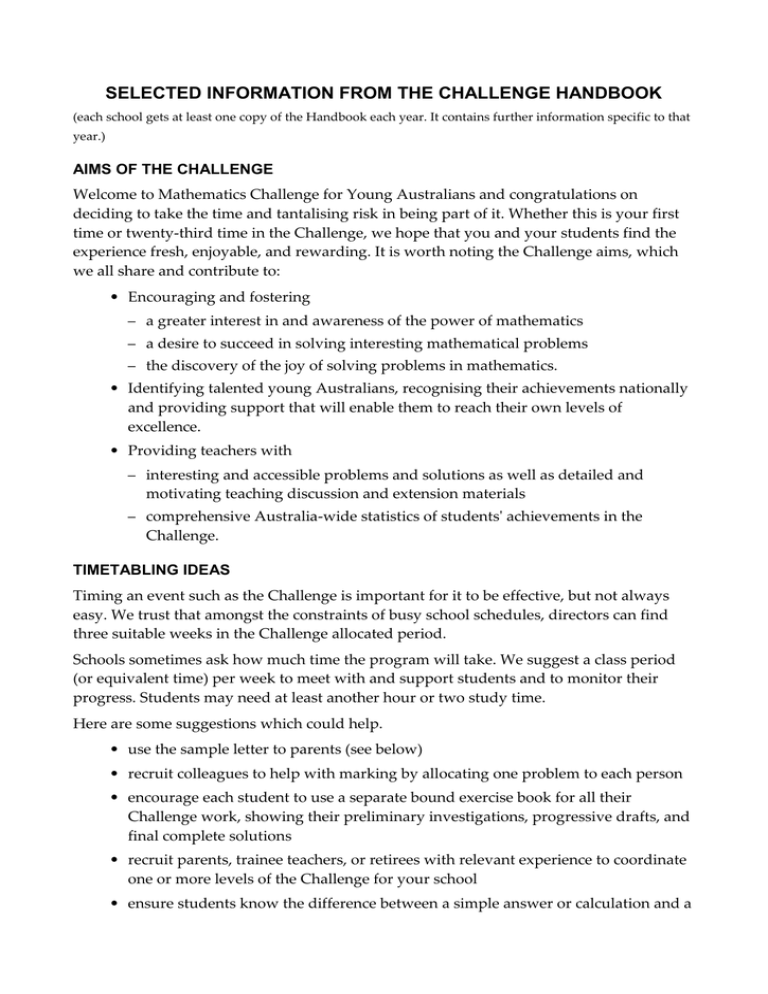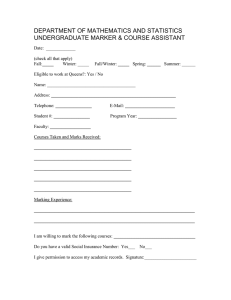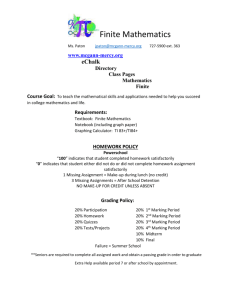Challenge Information - Australian Mathematics Trust
advertisement

SELECTED INFORMATION FROM THE CHALLENGE HANDBOOK (each school gets at least one copy of the Handbook each year. It contains further information specific to that year.) AIMS OF THE CHALLENGE Welcome to Mathematics Challenge for Young Australians and congratulations on deciding to take the time and tantalising risk in being part of it. Whether this is your first time or twenty-third time in the Challenge, we hope that you and your students find the experience fresh, enjoyable, and rewarding. It is worth noting the Challenge aims, which we all share and contribute to: • Encouraging and fostering – a greater interest in and awareness of the power of mathematics – a desire to succeed in solving interesting mathematical problems – the discovery of the joy of solving problems in mathematics. • Identifying talented young Australians, recognising their achievements nationally and providing support that will enable them to reach their own levels of excellence. • Providing teachers with – interesting and accessible problems and solutions as well as detailed and motivating teaching discussion and extension materials – comprehensive Australia-wide statistics of students' achievements in the Challenge. TIMETABLING IDEAS Timing an event such as the Challenge is important for it to be effective, but not always easy. We trust that amongst the constraints of busy school schedules, directors can find three suitable weeks in the Challenge allocated period. Schools sometimes ask how much time the program will take. We suggest a class period (or equivalent time) per week to meet with and support students and to monitor their progress. Students may need at least another hour or two study time. Here are some suggestions which could help. • use the sample letter to parents (see below) • recruit colleagues to help with marking by allocating one problem to each person • encourage each student to use a separate bound exercise book for all their Challenge work, showing their preliminary investigations, progressive drafts, and final complete solutions • recruit parents, trainee teachers, or retirees with relevant experience to coordinate one or more levels of the Challenge for your school • ensure students know the difference between a simple answer or calculation and a full solution with reasoned argument • encourage feeder primary and other schools to participate in the Challenge so there is a wider pool of experience and support amongst local colleagues • set early deadlines for some problems so they can be marked while students work on others • explain to students any unfamiliar terms in a problem and clarifying a question where necessary. MARKING Marking is always a quandary. The Problems Committee endeavours to present problems, marking schemes and model solutions so they indicate as precisely as possible how marks should be allocated. Nevertheless discretion is often required, particularly for reasoning and explanation. Where there is only one mark available, the desire to award a half mark is strong; the stipulation not to do so is seen as unfair. However, students have three weeks to prepare and revise their solutions so they are correct and complete. Past Challenge problems and solutions can help them see what is expected. Encourage students to criticise their own writing, to look at their solution as building a bridge of understanding. Half a bridge will never do but where there is doubt, award the mark. SAMPLE LETTER TO PARENTS Dear Parents, Your child has been selected to participate in the Challenge Stage of the Mathematics Challenge for Young Australians (MCYA). This is a problem-solving activity organised by the Australian Mathematics Trust, which is aimed at the top 15% of students in their year level. The MCYA Challenge Stage takes place over three weeks in Term 1 or Term 2. Students receive a problem book containing 6 problems (Years 7 to 10 – Junior and Intermediate levels) or 4 problems (Years 5 to 7 – Primary level). Students are required to present written solutions to as many of these problems as they can. The problems are challenging and require time and persistence, but are based on mathematics which should be known at that level. Students in the Junior and Intermediate levels may work with a partner on two of the problems, students in the Primary level may work in groups of up to three on all the problems. Individual solutions must be submitted. Teachers mark the submitted solutions from marking schemes and solutions provided by the Australian Mathematics Trust in the Teacher Guide. This also provides alternative solutions, some discussion of the origin, mathematics and teaching issues associated with each problem, and some extension problems with solutions; it is a valuable classroom resource. Marks are submitted to the Australian Mathematics Trust and, after processing, certificates are issued. Students are allowed to seek help from any resources other than human ones – textbooks, encyclopedias, etc., calculators and computers. Note that websites offering help with problems are really human resources and not allowed, but the use of a computer-based encyclopedia or a website providing information of a general nature is quite alright. Teachers will be checking on progress from time to time and may be able to answer questions of clarification. Some classtime will be set aside for consultation with partners. I hope the MCYA Challenge Stage is an enjoyable and valuable learning experience for your child. ADMINISTRATIVE PROCEDURES AND GUIDELINES A On receipt of the Challenge Stage Package You should have: • MCYA Challenge Stage Director’s Handbook • Return address envelope (plastic) containing: – Answer sheets – School Details form / MCYA Questionnaire (yellow) – AMOC High School Mathematics Problem-Solving Program brochure – Australian Mathematics Trust Publications order form • Sealed package containing: – Student Problems books (Primary, Junior and Intermediate) • Sealed complimentary Teacher set(s) containing: – Teacher Guide with solutions and marking schemes for the Challenge Stage problems, as well as extension material – One each of the Primary, Junior and Intermediate Problems books. The Challenge Committee strongly recommends to schools that they formally allocate, if possible, special class periods on the school’s timetable. This recommendation is based on the comments and suggestions of many teachers who reported most positively of the benefits to their students of similar arrangements made in previous Challenge and Enrichment Stages. Included at the back of the handbook are brief solutions to each problem. These may be photocopied and given to students after mid-June. Do not give them to students earlier, even if they finish the Challenge Stage earlier — friends in other schools may still be working on it. Do not use these solutions for marking the students’ efforts, use the solutions and marking scheme in the Teacher Guide. To help teachers with marking deadlines, it is suggested that students hand in their completed problems progressively. B The day when students are given their Challenge Stage Problems Arrange a meeting of all students participating in the Challenge Stage. (a) Collect the information below for each student to record on your spreadsheet, OR ask each student to complete an answer sheet, using a soft lead pencil (e.g. 2B), including: • their surname and first name • school year, sex, date of birth • name and address of school • answers for the two questions asked at the bottom of the answer sheet. Collect and secure the information or answer sheets for later coding of students’ marks and level attempted. (b) (c) C Give the Student Problems books and any photocopied sheets to each participant, making sure that they understand the ‘Instructions to Students’ at the front of their book and the ‘Mark Allocation’ at the back of their book. Outline arrangements made for monitoring progress and handing in solutions. The day when students hand in their attempts to the Challenge Stage Problems Collect the answer sheets or student information and the Teacher Guide from the secure place. Collect the students’ Challenge Stage scripts ensuring that they have clearly recorded their names on their scripts. For Junior and Intermediate students check and record whether the students have attempted Problems 5 and/or 6 individually or have discussed these problems with a partner, and if so, have recorded their partner’s name. Marking Papers (a) Award marks as shown in the mark allocation (see Teacher Guide). Marks are to be awarded in whole numbers only. Be lenient — if you are unsure whether a mark should be awarded or not, award it (always give the student the benefit of the doubt). Be particularly lenient with reasoning marks, as students at this level are usually inexperienced at writing reasons. Students’ solutions need not be as detailed as those given here. Sometimes a brief interview with the student can clarify whether the student deserves the mark or not. No half marks are to be awarded. (b) If an incomplete attempt is presented, which is different from the solution supplied, award marks for comparable work. If you are not sure, again give the student the benefit of the doubt. We have identified several alternative solutions for each problem. Recording Results and Name Details Results may be submitted electronically on the spreadsheet or manually on the printed answer sheets. If using the answer sheets, code in all required information using a soft lead pencil (e.g. 2B). Rub out mistakes completely with a plastic eraser and re-code. Post in the plastic envelope provided. Please also complete the School Details form and MCYA Questionnaire either electronically or by hand, returning it with your answer sheets. D Submit results to the Australian Mathematics Trust by end June Return spreadsheets by email or send (express post or courier etc.) the answer sheets in the return address envelope to: Australian Mathematics Trust University of Canberra Locked Bag 1 Canberra GPO ACT 2601 Note: The overall results, statistics and award certificates will be posted to participating schools in late July. E Follow-up Support for Students 1. We suggest that teachers discuss the solutions of the Challenge Stage problems with their students. We supply a set of short solutions at the back of this handbook, which may be photocopied, distributed to students and used as a basis for discussion. 2. To help further motivate and challenge the students, a number of extension problems are provided in the Teacher Guide. We recommend that students should be given these further problems to help reinforce the concepts and ideas already met in the Challenge Stage problems and to provide further practice in problem solving. 3. Students who have done well or who have shown commitment in either of the Primary, Junior or Intermediate divisions should be encouraged to participate in the Enrichment Stage. It is not too late to enter as it is designed to be scheduled, by the school, in a convenient set of 12–16 weeks between April and September. 4. Australian Intermediate Mathematics Olympiad Students who do well or show commitment in the Challenge and/or Enrichment Stages should be encouraged to enter the Australian Intermediate Mathematics Olympiad (AIMO) which will be held in September. It is a four-hour, closed book contest, consisting of ten questions based on broad mathematical ideas. Students sit the AIMO at their own schools, and papers are sent to AMOC State Directors for marking. (Register students online using the same codes as for the Challenge.) The AIMO is the major identifier of students who will be invited to participate in the AMOC’s other activities such as the Maths Extension Programs and Residential Schools. HOW MUCH MAY A TEACHER HELP? It is stated in the instructions to students that solutions to the problems must be completely the work of the student and that students may seek the use of resources such as textbooks or library books, computers and calculators, but may not seek help from other people. Where problems are designated for discussion with a partner (or partners), the final solutions must be written out by each entrant individually and in the student's own words. However, where there are circumstances in which students cannot proceed, perhaps because of language or terminology, teachers may give some guidance. Further, general problem-solving techniques may be discussed. We suggest that the teacher negotiate arrangements whereby students report on their progress at regular intervals during the course of the Challenge. This will encourage the student to discuss any difficulties in getting started and to spread his or her efforts over the three weeks, rather than leaving it until the last minute. The following guidelines are designed to assist teachers in deciding what they may tell students. • Help if asked, but only give as much as will get the student thinking in the right direction. • Give hints very sparingly, and never in such a way that a solution is directly revealed. • Direct the student to consider a similar problem on a smaller scale. • Suggest, where appropriate, that the student make a table, list, diagram, etc. • Remind the student: ‘There are more options than you think. Can you look at it another way?’ Don’t show the other way(s), but rather force the student to take a broader view and consider alternatives. • Ask the student to give a wrong answer and explain why it is wrong. This may provide an entry point to a solution. • Help clarify the student’s thinking by asking questions such as: – Do you understand the question? – What are you told in the question? – What are you required to find? – Are you using all the information? – Do you understand the terminology? – What have you found so far? • Make sure that the student has noted the need to show uniqueness of a solution to some problems. This means that full marks will not be awarded for a solution established by ‘guess-and-check’ or a spreadsheet, unless the student demonstrates that all possible values have been tried. Teachers may assist with the terminology. For example, words such as ‘adjacent’ may need to be explained, as may the means by which scientific notation is displayed on the calculator. A general discussion of exponents and scientific notation may be necessary. Encourage students to look things up and lead them to suitable references and resources, if necessary. Don’t ignore the potential of a mathematical dictionary. The Instructions to Students in the Student Problem booklets advise that, except for specified student collaboration, students may not seek help from other people, including people whom they could contact via the internet. This has become a significant issue in recent years. Some students have submitted problems to one or more problem-solving web sites and simply waited for a solution to be provided by another user. This form of plagiarism can usually be detected by the deviation in style, accuracy, and sophistication from the student’s usual work. [Then follow suggestions regarding each question in the Challenge. The teacher should help only when help is requested.]

